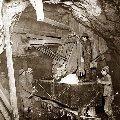Seeking Answers to the Universe, in an Old Gold Mine in South Dakota
VOICE ONE: Finally, a former gold mine seems like an unlikely place to study the universe. But that is just what scientists are planning to do deep below the Black Hills in South Dakota. That is where the Homestake Gold Mine is being prepared to become the world's deepest underground science laboratory. Scientists say the old mine is the perfect place to study dark matter. Scientists have wondered about mysterious dark matter particles for more than seventy years. The idea is that the matter we see does not have enough gravitational pull to keep galaxies together. Dark matter is believed to represent nearly one fourth of the universe's total mass. Scientists can observe what they believe to be dark matter only through its gravity.
VOICE TWO: The Homestake Gold Mine was chosen to study dark matter because it is largely protected from the radiation that could interfere with the project. The deepest part of the mine is nearly two thousand five hundred meters below ground. Some experiments are already taking place in the mine at a depth of about one thousand five hundred meters.
Homestake operated as a gold mine for one hundred twenty-five years before closing about nine years ago. However, this is not the first time the mine has been used for science. In the nineteen sixties, Ray Davis Junior used the mine for his work showing the existence of solar neutrinos. He and another scientist, John Bahcall, received the Nobel Prize for physics for their work.
Pumps that were used to keep the mine dry have not been in operation since its closure. So today, before the new research can begin, water must be removed from the mine. Workers must also build new structural supports in the mine to ensure its safety.
VOICE ONE: Two experiments are already planned for the mine. The first is the Large Underground Xenon detector experiment, or LUX. It will include a three hundred kilogram tank of liquid xenon. That container will be inside an even larger one filled with extremely pure water. If dark matter particles exist, scientists say, they should be able to observe a small amount of light given off when they hit the nucleus of a xenon atom.
The United States Department of Energy and the National Science Foundation approved more than one million dollars to pay for the experiment. The scientists plan to begin work on the project later this year. They are hoping to learn more about dark matter in an effort to better understand how the universe expands and shrinks.
VOICE TWO: The second planned experiment is called Majorana. In this project, scientists hope to prove that neutrinos have mass. They hope to begin this experiment later this year.
Researchers are awaiting approval of additional money from Congress so that two deeper laboratories can be built. The researchers want to begin building those laboratories by two thousand twelve. They hope to have them open by two thousand sixteen. The projects are expected to cost five hundred fifty million dollars.
(MUSIC) VOICE ONE: This SCIENCE IN THE NEWS was written by Mario Ritter, Marisel Salazar and Brianna Blake, who was also our producer. I'm Faith Lapidus. VOICE TWO: And I'm Bob Doughty. Read and listen to our programs at voaspecialenglish.com. Join us again next week for more news about science in Special English on the Voice of America.

